[English] 日本語
 Yorodumi
Yorodumi- PDB-8tow: Structure of a mutated photosystem II complex reveals perturbatio... -
+ Open data
Open data
- Basic information
Basic information
| Entry | Database: PDB / ID: 8tow | |||||||||
|---|---|---|---|---|---|---|---|---|---|---|
| Title | Structure of a mutated photosystem II complex reveals perturbation of the oxygen-evolving complex | |||||||||
 Components Components |
| |||||||||
 Keywords Keywords | PHOTOSYNTHESIS / photosystem II / oxygen-evolving complex / D1-D170E / S1 state / transition metals / metalloenzyme | |||||||||
| Function / homology |  Function and homology information Function and homology informationplasma membrane-derived thylakoid photosystem II / photosystem II oxygen evolving complex / photosystem II assembly / oxygen evolving activity / photosystem II stabilization / photosystem II reaction center / photosystem II / oxidoreductase activity, acting on diphenols and related substances as donors, oxygen as acceptor / photosynthetic electron transport chain / photosystem II ...plasma membrane-derived thylakoid photosystem II / photosystem II oxygen evolving complex / photosystem II assembly / oxygen evolving activity / photosystem II stabilization / photosystem II reaction center / photosystem II / oxidoreductase activity, acting on diphenols and related substances as donors, oxygen as acceptor / photosynthetic electron transport chain / photosystem II / response to herbicide / extrinsic component of membrane / chlorophyll binding / plasma membrane-derived thylakoid membrane / photosynthetic electron transport in photosystem II / : / phosphate ion binding / photosynthesis, light reaction / photosynthesis / respiratory electron transport chain / manganese ion binding / electron transfer activity / protein stabilization / iron ion binding / heme binding / calcium ion binding / metal ion binding / identical protein binding Similarity search - Function | |||||||||
| Biological species |  | |||||||||
| Method | ELECTRON MICROSCOPY / single particle reconstruction / cryo EM / Resolution: 2.14 Å | |||||||||
 Authors Authors | Flesher, D.A. / Liu, J. / Wang, J. / Gisriel, C.J. / Yang, K.R. / Batista, V.S. / Debus, R.J. / Brudvig, G.W. | |||||||||
| Funding support |  United States, 1items United States, 1items
| |||||||||
 Citation Citation |  Journal: J Biol Chem / Year: 2024 Journal: J Biol Chem / Year: 2024Title: Mutation-induced shift of the photosystem II active site reveals insight into conserved water channels. Authors: David A Flesher / Jinchan Liu / Jimin Wang / Christopher J Gisriel / Ke R Yang / Victor S Batista / Richard J Debus / Gary W Brudvig /  Abstract: Photosystem II (PSII) is the water-plastoquinone photo-oxidoreductase central to oxygenic photosynthesis. PSII has been extensively studied for its ability to catalyze light-driven water oxidation at ...Photosystem II (PSII) is the water-plastoquinone photo-oxidoreductase central to oxygenic photosynthesis. PSII has been extensively studied for its ability to catalyze light-driven water oxidation at a MnCaO cluster called the oxygen-evolving complex (OEC). Despite these efforts, the complete reaction mechanism for water oxidation by PSII is still heavily debated. Previous mutagenesis studies have investigated the roles of conserved amino acids, but these studies have lacked a direct structural basis that would allow for a more meaningful interpretation. Here, we report a 2.14-Å resolution cryo-EM structure of a PSII complex containing the substitution Asp170Glu on the D1 subunit. This mutation directly perturbs a bridging carboxylate ligand of the OEC, which alters the spectroscopic properties of the OEC without fully abolishing water oxidation. The structure reveals that the mutation shifts the position of the OEC within the active site without markedly distorting the MnCaO cluster metal-metal geometry, instead shifting the OEC as a rigid body. This shift disturbs the hydrogen-bonding network of structured waters near the OEC, causing disorder in the conserved water channels. This mutation-induced disorder appears consistent with previous FTIR spectroscopic data. We further show using quantum mechanics/molecular mechanics methods that the mutation-induced structural changes can affect the magnetic properties of the OEC by altering the axes of the Jahn-Teller distortion of the Mn(III) ion coordinated to D1-170. These results offer new perspectives on the conserved water channels, the rigid body property of the OEC, and the role of D1-Asp170 in the enzymatic water oxidation mechanism. | |||||||||
| History |
|
- Structure visualization
Structure visualization
| Structure viewer | Molecule:  Molmil Molmil Jmol/JSmol Jmol/JSmol |
|---|
- Downloads & links
Downloads & links
- Download
Download
| PDBx/mmCIF format |  8tow.cif.gz 8tow.cif.gz | 1.2 MB | Display |  PDBx/mmCIF format PDBx/mmCIF format |
|---|---|---|---|---|
| PDB format |  pdb8tow.ent.gz pdb8tow.ent.gz | 1 MB | Display |  PDB format PDB format |
| PDBx/mmJSON format |  8tow.json.gz 8tow.json.gz | Tree view |  PDBx/mmJSON format PDBx/mmJSON format | |
| Others |  Other downloads Other downloads |
-Validation report
| Summary document |  8tow_validation.pdf.gz 8tow_validation.pdf.gz | 8.8 MB | Display |  wwPDB validaton report wwPDB validaton report |
|---|---|---|---|---|
| Full document |  8tow_full_validation.pdf.gz 8tow_full_validation.pdf.gz | 9.4 MB | Display | |
| Data in XML |  8tow_validation.xml.gz 8tow_validation.xml.gz | 265.3 KB | Display | |
| Data in CIF |  8tow_validation.cif.gz 8tow_validation.cif.gz | 347.5 KB | Display | |
| Arichive directory |  https://data.pdbj.org/pub/pdb/validation_reports/to/8tow https://data.pdbj.org/pub/pdb/validation_reports/to/8tow ftp://data.pdbj.org/pub/pdb/validation_reports/to/8tow ftp://data.pdbj.org/pub/pdb/validation_reports/to/8tow | HTTPS FTP |
-Related structure data
| Related structure data |  41460MC M: map data used to model this data C: citing same article ( |
|---|---|
| Similar structure data | Similarity search - Function & homology  F&H Search F&H Search |
- Links
Links
- Assembly
Assembly
| Deposited unit | 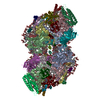
|
|---|---|
| 1 |
|
- Components
Components
-Photosystem II ... , 17 types, 34 molecules AaBbCcDdHhIiJjKkLlMmOoRrTtUuXx...
| #1: Protein | Mass: 39758.141 Da / Num. of mol.: 2 / Source method: isolated from a natural source / Source: (natural)  #2: Protein | Mass: 55954.355 Da / Num. of mol.: 2 / Source method: isolated from a natural source / Source: (natural)  #3: Protein | Mass: 50344.723 Da / Num. of mol.: 2 / Source method: isolated from a natural source / Source: (natural)  #4: Protein | Mass: 39519.238 Da / Num. of mol.: 2 / Source method: isolated from a natural source / Source: (natural)  #7: Protein | Mass: 7120.404 Da / Num. of mol.: 2 / Source method: isolated from a natural source / Source: (natural)  #8: Protein/peptide | Mass: 4338.119 Da / Num. of mol.: 2 / Source method: isolated from a natural source / Source: (natural)  #9: Protein/peptide | Mass: 3976.687 Da / Num. of mol.: 2 / Source method: isolated from a natural source / Source: (natural)  #10: Protein/peptide | Mass: 5114.127 Da / Num. of mol.: 2 / Source method: isolated from a natural source / Source: (natural)  #11: Protein/peptide | Mass: 4476.145 Da / Num. of mol.: 2 / Source method: isolated from a natural source / Source: (natural)  #12: Protein/peptide | Mass: 3910.639 Da / Num. of mol.: 2 / Source method: isolated from a natural source / Source: (natural)  #13: Protein | Mass: 29939.584 Da / Num. of mol.: 2 / Source method: isolated from a natural source / Source: (natural)  #15: Protein/peptide | Mass: 4204.958 Da / Num. of mol.: 2 / Source method: isolated from a natural source / Source: (natural)  #16: Protein/peptide | Mass: 3571.318 Da / Num. of mol.: 2 / Source method: isolated from a natural source / Source: (natural)  #17: Protein | Mass: 14256.163 Da / Num. of mol.: 2 / Source method: isolated from a natural source / Source: (natural)  #19: Protein/peptide | Mass: 4189.036 Da / Num. of mol.: 2 / Source method: isolated from a natural source / Source: (natural)  #20: Protein/peptide | Mass: 4143.993 Da / Num. of mol.: 2 / Source method: isolated from a natural source / Source: (natural)  #21: Protein | Mass: 6736.161 Da / Num. of mol.: 2 / Source method: isolated from a natural source / Source: (natural)  |
|---|
-Cytochrome b559 subunit ... , 2 types, 4 molecules EeFf
| #5: Protein | Mass: 9454.577 Da / Num. of mol.: 2 / Source method: isolated from a natural source / Source: (natural)  #6: Protein/peptide | Mass: 4935.784 Da / Num. of mol.: 2 / Source method: isolated from a natural source / Source: (natural)  |
|---|
-Protein , 2 types, 4 molecules QqVv
| #14: Protein | Mass: 16494.934 Da / Num. of mol.: 2 / Source method: isolated from a natural source / Source: (natural)  #18: Protein | Mass: 17901.045 Da / Num. of mol.: 2 / Source method: isolated from a natural source / Source: (natural)  |
|---|
-Sugars , 2 types, 72 molecules 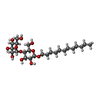


| #31: Sugar | ChemComp-LMT / #34: Sugar | ChemComp-DGD / |
|---|
-Non-polymers , 15 types, 1430 molecules 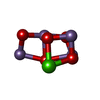






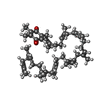

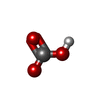



















| #22: Chemical | | #23: Chemical | #24: Chemical | ChemComp-CL / #25: Chemical | ChemComp-CLA / #26: Chemical | ChemComp-PHO / #27: Chemical | ChemComp-BCR / #28: Chemical | ChemComp-LMG / #29: Chemical | ChemComp-PL9 / #30: Chemical | ChemComp-SQD / #32: Chemical | #33: Chemical | ChemComp-LHG / #35: Chemical | ChemComp-HEM / #36: Chemical | #37: Chemical | ChemComp-CA / #38: Water | ChemComp-HOH / | |
|---|
-Details
| Has ligand of interest | Y |
|---|---|
| Has protein modification | Y |
-Experimental details
-Experiment
| Experiment | Method: ELECTRON MICROSCOPY |
|---|---|
| EM experiment | Aggregation state: PARTICLE / 3D reconstruction method: single particle reconstruction |
- Sample preparation
Sample preparation
| Component | Name: photosystem II / Type: COMPLEX / Entity ID: #1-#21 / Source: NATURAL |
|---|---|
| Source (natural) | Organism:  |
| Buffer solution | pH: 6.8 |
| Specimen | Embedding applied: NO / Shadowing applied: NO / Staining applied: NO / Vitrification applied: YES |
| Vitrification | Cryogen name: ETHANE |
- Electron microscopy imaging
Electron microscopy imaging
| Experimental equipment |  Model: Titan Krios / Image courtesy: FEI Company |
|---|---|
| Microscopy | Model: FEI TITAN KRIOS |
| Electron gun | Electron source:  FIELD EMISSION GUN / Accelerating voltage: 300 kV / Illumination mode: FLOOD BEAM FIELD EMISSION GUN / Accelerating voltage: 300 kV / Illumination mode: FLOOD BEAM |
| Electron lens | Mode: BRIGHT FIELD / Nominal defocus max: 2000 nm / Nominal defocus min: 1000 nm |
| Image recording | Electron dose: 38 e/Å2 / Film or detector model: GATAN K3 (6k x 4k) |
- Processing
Processing
| CTF correction | Type: PHASE FLIPPING AND AMPLITUDE CORRECTION |
|---|---|
| 3D reconstruction | Resolution: 2.14 Å / Resolution method: FSC 0.143 CUT-OFF / Num. of particles: 129229 / Symmetry type: POINT |
 Movie
Movie Controller
Controller


 PDBj
PDBj
































